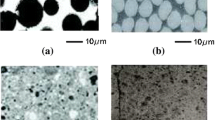The use of nanomaterials for the implementation of a new set of functional properties has no alternative when creating refractory composite materials. Fine-dispersed Al2O3 is a necessary component of special high-quality cements, heat-resistant inert refractories and abrasive materials. Equations are obtained for the average values of the Euler and Reynolds criteria, the relaxation time of liquid droplets with integrated nanoparticles depending on their median size in the process of hydro-vortex classification. The tests carried out confirmed that under the conditions of self-similar hydro-vortex coagulation in the process of hydro-vortex classification, the inertial forces acting on the unsteady hydro-vortex motion of the dispersed system a drop of liquid — a microparticle of material, significantly affect the trajectory of its motion in comparison with the forces acting in the direction of motion of the fluidized bed of dispersed material. In this case, the control action provides a constant relaxation time, which significantly increases the efficiency of the influence of the angular velocity of droplet rotation on the classification process. Thus, inertial hydro-vortex classification in the self-similarity mode makes it possible to control the trajectories of motion of microparticles. At the same time, the energy of the translational motion of liquid droplets, determined by the characteristics of the hydro-vortex nozzles of the aerator, ensures the constancy of the time of the inlet manifold of the receiving hopper for relaxation, allowing the median diameter range of 0.5 × 10–6 – 5 × 10–6 m to be provided with a dispersion of no more than 20 % on their median diameter with a larger width of the inlet header of the receiving hopper.



Similar content being viewed by others
References
Yu. I. Gordeev, A. K. Abkaryan, G. M. Zeer, et al., “Influence of additives alloying ceramic nanoparticles on the structural parameters and properties of hard alloys” [in Russian], Vestnik Sibirskogo Gosudarstvennogo Aerokosmicheskogo Universiteta imeni Akademika M. F. Reshetneva, [Bulletin of the Siberian State Aerospace University named after Academician M. F. Reshetnev], No. 3, 174 – 181 (2013).
S. V. Kovshov and V. P. Kovshov, “Chemical technology of dust suppression on open-pit mines,” International Journal of Ecology and Development, 30(3), 55 – 67 (2015).
S. Ya. Davydov, R. A. Apakashev, and V. N. Korukov, “Utilization of alumina calcining furnace dust containing nanoparticles,” Refract. Ind. Ceram., 55(4), 291 – 294 (2014).
N. I. Alymenko, A. A. Kamenskikh, A. V. Nikolaev, and A. I. Petrov, “Numerical modeling of heat and mass transfer during hot and cool air mixing in a supplyshaft in underground mine,” Eurasian Mining, No. 2, 45 – 47 (2016).
S. Ya. Davydov, R. A. Apakashev, and V. N. Korukov, “Capturing nanoparticles in alumina production,” Refract. Ind. Ceram., 57(1), 9 – 12 (2016).
D. Wu, K. Yin, Q. Yin, et al., “Reverse circulation drilling method based on a supersonic nozzle for dust control,” Applied sciences (Switzerland), 7(1), 5 – 20 (2017). DOI: https://doi.org/10.3390/APP7010005.
V. I. Lyashenko, A. Gurin, F. F. Topolniy, and N. A. Taran, “Justification of environmental technologies and means for dust control of tailing dumps surfaces of hydrometallurgical production and concentrating plants,” Metallurgical and Mining Industry, No. 4, 8 – 17 (2017).
V. N. Makarov and S. Ya. Davydov, “Theoretical basis for increasing ventilation efficiency in technological processes at industrial enterprises,” Refract. Ind. Ceram., 56(1), 103 – 106 (2015).
V. N. Makarov, S. Y. Davydov, and N. V. Makarov, “Genesis of ecotechnology efficiency in the production of dust-forming materials,” Refract. Ind. Ceram., 60(1), 115 – 119 (2019).
N. S. Novakovskiy and S. P. Bautin, “Numerical simulation of shock-free strong compression of 1d gas layer,” Journal of Physics: Conference Series, 894(1), p. 12067 (2017). DOI: https://doi.org/10.1088/1742-6596/894/1/012067.
V. N. Makarov, N. V. Makarov, V. V. Potapov, and E. M. Gorshkova, “A promising way of increasing the efficiency of high-pressure hydro-dusting” [in Russian], Vestnik ZabGU, 24(5), 13 – 20 (2018).
V. N. Makarov, N. P. Kosarev, N. V. Makarov, A. V. Ugolnikov, and A. V. Lifanov, “Effective localization of coal dust explosions using hydro-cyclonic coagulation” [in Russian], Vestnik Permskogo Natsionalnogo Issledovatel’skogo Politekhnicheskogo Universiteta, Geologiya. Neftegazovoye i Gornoe Delo, 18(2), 178 – 189 (2018).
A. V. Frolov, V. A. Telegin, and Yu. A. Sechkerev, “Fundamentals of hydro-dusting” [in Russian], Bezopasnost’ Zhiznedeyatel’nosti, No. 10, 1 – 24 (2007).
L. G. Loytsyansky, Mechanics of Liquid and Gas [in Russian], university textbook, 7th ed., Rev., Drofa, Moscow (2003) 840 p.
V. N. Makarov, A. V. Ugolnikov, and N. V. Makarov, “Optimization of geometric parameters of the hydro-vortex Venturi stratifier” [in Russian], Zapiski Gornogo Instituta, 240, 638 – 648 (2019).
V. A. Venikov, Theory of Similarity and Modeling as Applied to the Tasks of the Electric Power Industry [in Russian], university textbook, 4th ed., Librokom, Moscow (2014) 439 p.
N. A. Fuchs, Mechanics of Aerosols [in Russian], Publishing house of the Academy of Sciences of the USSR, Moscow (1955) 352 p.
Author information
Authors and Affiliations
Corresponding author
Additional information
Translated from Novye Ogneupory, No. 10, pp. 13 – 17, October 2020.
Rights and permissions
About this article
Cite this article
Makarov, V.N., Davydov, S.Y., Ugolnikov, A.V. et al. Hydro-Vortex Classification of Composite Microparticles. Refract Ind Ceram 61, 494–498 (2021). https://doi.org/10.1007/s11148-021-00510-x
Published:
Issue Date:
DOI: https://doi.org/10.1007/s11148-021-00510-x




